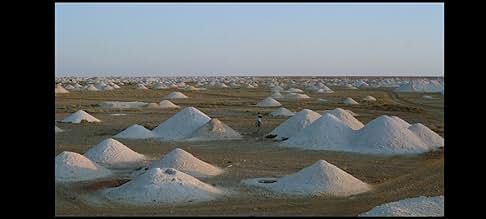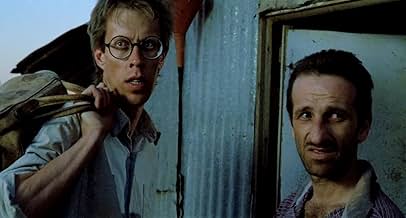Adicionar um enredo no seu idiomaA geologist employed by an Australian mining company finds himself disputing the rights of some aborigines who believe their land to be sacred.A geologist employed by an Australian mining company finds himself disputing the rights of some aborigines who believe their land to be sacred.A geologist employed by an Australian mining company finds himself disputing the rights of some aborigines who believe their land to be sacred.
- Prêmios
- 2 vitórias e 2 indicações no total
- Direção
- Roteiristas
- Elenco e equipe completos
- Produção, bilheteria e muito mais no IMDbPro
Avaliações em destaque
The overall effect of the film is wonderfully Herzog with a surrealistic portrayal of the clash of old and new, progress versus conservation and fraught with cultural miscommunication. I really recommend this film for your viewing.
There is a small scene in an elevator that I remember as a transcendent cinematic moment.
Like so many of Herzog's films, it is deeply moving for reasons that aren't easy to put your finger on - often with Herzog it's an odd juxtaposition, an awkward silence, a strange edit, an inappropriate flash of humour or horror that produce a flash of insight.
This film, at the time, seemed conventional by Herzog's standards, but I still left the theatre feeling slightly drugged, always a good sign.
Well, Green Ants proves me wrong. This is a great film that shows the conflict between white and aboriginal civilizations without being sentimental or condescending to either side. With Hollywood we'd some cliché about noble savages and suchlike, but here you get the feeling of dealing with real human beings.
Oh yeah, the plot deals with an Australian mining company that wants to blow up a sacred site to do mineral exploitation. Herzog avoids stereotyped poses to bring out the situation as it would occur in real life. Plus you get some great shots of the outback.
I plan to lend this one to all my aboriginal friends!
His films are simply conceived, like Lynch's, but once he gets rolling, his intuitions take him to strange, exotic corners of the soul. There he leaves traces that last. I love the man's work, much of it. I love the fact that he really seems to be driven by urges that seem to accidentally result in something that can cross the distribution divide to reach me. This is no small feat; the films I watch that have ideas and matter are what maybe a millionth, a billionth? of the similarly deep insights and artifacts that would have similar effect in me, but which cannot cross that divide.
When I watch his work, some of which I reserve for the future, it is a dip into the film of Herzog. Failures add to this. Risks that did not pan out for him, do for me.
This film has some heavy disadvantages. He is in Australia and he simply does not understand that to photograph the land the way it affects its inhabitants, you have to photograph nothing. Nothing is what matters. But he gives us a tornado. Its beautiful and violent it even fits the story. He gives us unrelenting piles of boring waste. This too is effective in the film, but not of the place.
He misses both the place and he people. He does give us beautiful Aboriginal faces. He does celebrate them. But its from a deeply disturbing patriarchal, colonial perspective. There is some of this in his Peruvian adventures, but it is hidden in his respect for the Jungle. The natives are simply part of the terrain. He cannot do that here. This also suffers in that he felt it necessary to have an on-screen observer who "learns" the value of the place and turns from heading the mining effort to living with the people.
The result is that the film is overt in its sentiments, but everything works against its honesty. We are left with having to accept it locally, each scene as a sort of standalone taste: black patient faces staring out of pilot seats in an airplane given to them; a man on a witness stand testifying in a language no other soul on the planet understands; an old biddy waiting in the sun at a mine opening on the of chance that her beloved doggie will reappear; that tornado; the (overearnest) story of the sleeping green ants whose dreams we are.
This has value in those small pieces, pretty much throughout. But in the large, taken the way he intends it, its just a colonial German peering into a quaint culture as an ordinary tourist would. So it dilutes the greater story, the greater film of the man.
Ted's Evaluation -- 2 of 3: Has some interesting elements.
Você sabia?
- CuriosidadesThe whole story of the green ants was made up by Werner Herzog, it's not a part of genuine Aboriginal folklore. However the courtroom incident where a secret artifact is revealed, to the bemusement of the judge, is based on a real incident.
- Citações
Lance Hackett: The situation, your Honor, is this man is the the sacred custodian to the secrets of this tribe. And his tribe has died out. He is the sole and final survivor of his people, his clan. They call him the mute, because there is nobody left on this earth for him to speak with.
- ConexõesFeatured in O Mundo Contemplativo de Herzog (1989)
- Trilhas sonorasRequiem Op. 48
Music by Gabriel Fauré
Principais escolhas
- How long is Where the Green Ants Dream?Fornecido pela Alexa
Detalhes
- Data de lançamento
- País de origem
- Idioma
- Também conhecido como
- Where the Green Ants Dream
- Locações de filme
- Empresas de produção
- Consulte mais créditos da empresa na IMDbPro
- Tempo de duração1 hora 40 minutos
- Mixagem de som
- Proporção
- 1.85 : 1
Contribua para esta página































